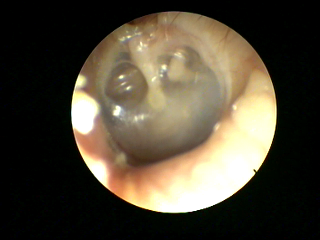What is the Eustachian tube and what does it do?
The Eustachian tube is a narrow tube that connects the middle ear with the back of the nose. The middle ear space behind the eardrum is normally filled with air.
The Eustachian tube is normally closed but opens from time to time when we swallow, yawn or chew. This allows air to flow into the middle ear, and any mucus to flow out. This keeps the air pressure equal either side of the eardrum, enables the eardrum to work and vibrate properly which is needed to hear properly.
What is Eustachian tube dysfunction?
Eustachian tube dysfunction (ETD) means that the Eustachian tube is blocked or does not open properly. In other words, it is closed when it should be open. This pushes the eardrum inward. The eardrum becomes tense and does not vibrate so well when hit by sound waves.
What are the symptoms of Eustachian tube dysfunction?
The eardrum becomes tense and does not vibrate so well when hit by sound waves causing muffled or dulled hearing. You may also have ear pain because the eardrum is tensed and stretched. Other symptoms that may also develop include: a feeling of fullness in the ear; tinnitus (ringing or buzzing in the ear); dizziness. A tube that is too open can also cause a persistent feeling of pressure as well as hearing unusual sounds such as your own breathing or your own voice too loudly.
What are the causes?
Colds and other nose, sinus, ear or throat infections: This is the common cause of ETD. The blocked nose, or thick mucous that develops during a cold or other infections may block the Eustachian tube. An infection may also cause the lining of the Eustachian tube to become inflamed and swollen.
Allergies Allergies that affect the nose can cause extra mucus and inflammation in and around the Eustachian tube and lead to ETD.
Blockages Anything that causes a blockage to the Eustachian tube can cause ETD. For example, enlarged adenoids. Rarely, ETD can be a symptom of rare tumours that sometimes develop at the back of the nose. These will usually cause other symptoms in addition to ETD.
What is the treatment for Eustachian tube dysfunction?
Try to get air to flow into the Eustachian tube
Air is more likely to flow in and out of the Eustachian tube if you swallow, yawn or chew. Try doing the following. Take a breath in. Then, try to breathe out gently with your mouth closed and pinching your nose (the Valsalva manoeuvre). In this way, no air is blown out, but you are gently pushing air into the Eustachian tube. If you do this, you may feel your ears go ‘pop’ as air is forced into the middle ear. This sometimes eases the problem. This is a particularly good thing to try if you get ear pain when descending to land in a plane.
Decongestant nasal sprays or drops
These may be advised by your doctor if you have a cold or other cause of nasal congestion. You should not use a decongestant spray or drops for more than 5-7 days at a time. If they are used longer than this, they may cause a worse ‘rebound’ congestion in the nose.
Antihistamine tablets or nasal sprays
These may be advised by your doctor if you have an allergy such as hay fever. In this situation they will help to ease nasal congestion and inflammation.
Steroid nasal spray
A steroid nasal spray may be prescribed if an allergy or other cause of persistent inflammation in the nose is suspected. It works by reducing inflammation in the nose. It takes several days for a steroid spray to build up to its full effect. Therefore, you will not have an immediate relief of symptoms when you first start it.
Surgery
The goal of this treatment is to bypass your eustachian tubes and address ventilation problems in your middle ears. Myringotomy. During this procedure, the surgeon makes a small incision in the eardrum. In adults, the incision usually stays open long enough for the swelling in the eustachian tubes to resolve. In certain cases, Grommet, a very small plastic tube is put in the hole to let air in and out of the ear and to keep it healthy.


Recent Comments